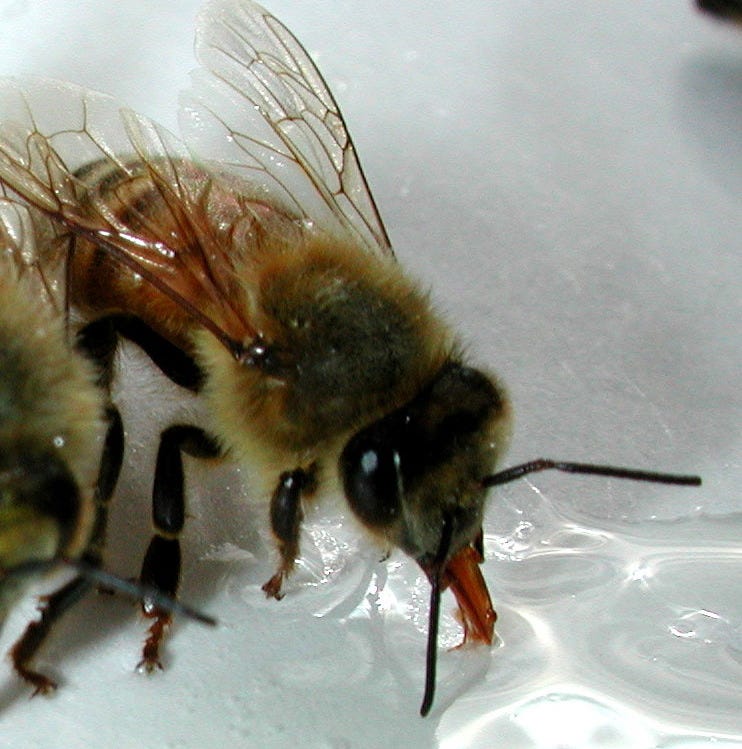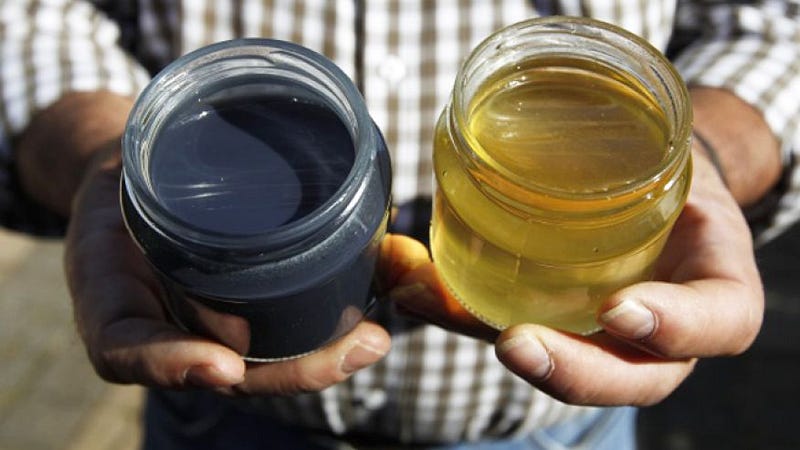Weekend Diversion: Funny Honey
What happens when honey bees feed on M&Ms?
“My therapist told me the way to achieve true inner peace is to finish what I start. So far today, I have finished 2 bags of M&M’s and a chocolate cake. I feel better already.” –Dave Barry
One of the problems with being a scientifically-minded kid is that you’re prone to not simply take someone’s word for the truth of statements, but have an innate need to test them out for yourself. You remember the old M&Ms slogan “the milk chocolate melts in your mouth, not in your hand,” right? Well, if you’ve ever tried it out for yourself — try holding a handful of M&Ms in your fist for a minute or two — you might discover something akin to what Great Lake Swimmers sang about in their song, Changing Colours.
As for me and my primitive M&Ms experiment, this picture accurately represents what I found…

followed immediately by my grandma screaming at me to wash my hands and not to touch anything. The reason why is obvious: the combination of sugar, food coloring and water would undoubtedly stain whatever it was I’d touch!
Now, with that in mind, imagine that you’re a bee.

What is it that you’re going to be drawn to? You might think that the sight of flowers with their segmented eye is what draws bees to them, but it turns out that eyesight in bees is vastly inferior to what, for example, humans experience, particularly at a distance of more than a few inches (or centimeters). Have a look at Andy Giger’s biologically accurate simulations of what a bee sees.

Instead — and particularly at large distances — bees locate food sources, mates, enemies and more primarily with their antennae, which is where their smell receptors are located! Their sense of smell is particularly good, much better even than fruit flies and other insects known for their ability to locate via scent.
Normally, that scent leads them to flowers and the sweet nectar inside, which they happily feed on.

Based on the anatomy of a bee, they don’t only pick up the sugar found in the nectar inside, but also pollen and other molecules — small and large — found in their favorite food sources. No wonder, when you look at the honey they wind up producing, it comes out looking like this, due to all the pollen (and more) that the bees bring back to the hive.

But sometimes, there’s a smell of an even stronger, sugarier food source nearby. And if that’s the case… well, there’s no telling what your bees might bring back.
So you can imagine the surprise that a cluster of French beekeepers started finding honeycombs that looked like this in their apiaries.

In the summer of 2012, bees in the northeast of France were seen returning to their hives with various shades of colors on their bodies. Instead of the customary yellow, bees were also seen returning colored blue, green, brown or red!
And when they went to harvest their honey, this is what they wound up finding.

As it so happened, the affected bee populations were located within 4 kilometers of a biogas plant that processes waste from… you guessed it: a factory that produces M&Ms! It turns out that residue from the colored candy shells wound up attracting the bees, who apparently couldn’t turn down the syrupy sweet allure of the free food, and came back carrying food dye particles instead of pollen, turning their honey all sorts of different colors depending on which color they discovered.

This isn’t the first time this has happened: in 2010, Brooklyn bees started producing sweet red goo instead of honey; apparently, they got access to a maraschino cherry factory, and took full advantage of the opportunity. As entomologist Dino Martins said,
“Honey bees will look for resources wherever they can find them. Just like us humans, they have a sweet tooth as they seek out nectar for making their honey.”

Alain Frieh, president of the apiculturists’ union, was quick to dispel the notion that this colored sweetness would be sold as honey, stating “For me, it’s not honey. It’s not sellable.” While you might think the obvious — honey comes from Skittles, not M&Ms — it’s because true honey needs to be unfiltered, have a high pollen count and enzyme content, among other criteria. Bees feeding on sugars primarily from sources other than flowers are likely to have their honey fail on the second count; without encountering pollen for their food, they’re not likely to produce honey with a significant amount of pollen at all.
Even though it’s not technically honey, it still definitely tastes like honey, and I’d be more than happy to buy a jar and test it out if I could!

So apparently, the colored candy shell melts in your mouth, your hands, and on the appendages of honey bees, too. Thanks for joining me for some unusual science this weekend, and I’ll see you during the week for more wonders of the Universe near and far!
Enjoyed this? Weigh in at the Starts With A Bang forum on Scienceblogs.





